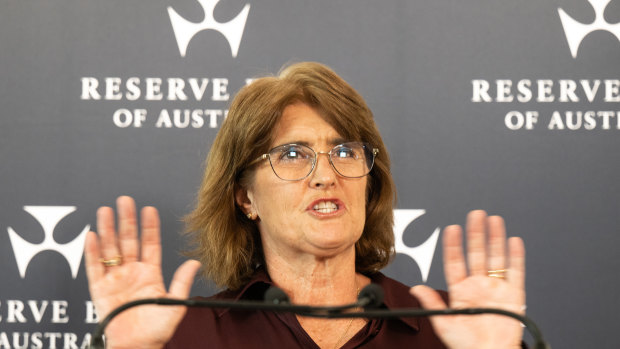- Analysis
- Politics
- Federal
- Interest rates
This was published 4 months ago
The only certainty for your mortgage rate – Reserve Bank uncertainty
By Shane Wright
If any economist tells you they know what the Reserve Bank will do next, ask them if they have the title deeds to the Sydney Harbour Bridge.
Because the minutes of the bank board’s latest meeting show it is at sixes and sevens trying to determine what is going on across the economy.

Reserve Bank governor Michele Bullock and the rest of the board are unsure how the economy is performing.Credit: Louie Douvis
The minutes, which cover the June board gathering at which the official cash rate was kept at 4.35 per cent, reveal that the bank’s core assumptions are being challenged by events playing out across the nation’s shopping malls.
The bank’s job is to identify how the economy will perform over the next 18 to 24 months. But the data of recent days and weeks is utterly confusing.
The most recent national accounts, which showed the economy expanded by just 0.1 per cent through the first three months of the year, revealed slightly higher-than-expected consumer spending, including on overseas holidays.
The same figures, however, showed the level of household savings was lower than had been generally accepted.
According to the minutes, this could mean one of two very different trends.
“One interpretation was that, on average, households were not being as cautious in their spending as previously thought. Another was that the fall in the saving rate would leave households even more financially squeezed than previously assessed,” the minutes noted.
In other words – either interest rates are not high enough to stop a family nicking off to Bali for a week-long holiday, or rates are so high that people are selling kidneys to make ends meet.
Further clouding the story, the bank had believed people were socking away extra cash in their mortgage offset accounts. If true, that would suggest households were dealing with current interest rate settings relatively comfortably.
But the drop-off in household savings, the minutes noted, “portrayed a different picture”.
For the first time, the minutes used the term “financially squeezed” to describe the nation’s households. That alludes to evidence coming in from charities, which are telling the Reserve Bank they are seeing more requests for help from people “who have not previously sought assistance, including wage-earners and those with mortgages”.
The share of household disposable income being used to cover mortgage repayments is at a record high, thanks in part to this nation’s crazy-stupid property market and the actions of the Reserve Bank.
Even this is sending mixed signals.
The bank concedes the higher payments are putting pressure on those who owe money, which is contributing to the weakness in household consumption. At the same time, extra mortgage repayments are a little above their pre-COVID-19 pandemic average.
Again, more confusion for the bank.
“This is consistent with the incentive for debtors to reduce their net debts where possible when interest rates are high. Members acknowledged, alternatively, that this could reflect concerns about the economic outlook,” the minutes noted.
Time and again, the minutes show the bank unsure of how the economy – and the inflation outlook – is playing out.
The case for an interest rate rise in effect rested on an argument that the economy was travelling too well to bring inflation down to the bank’s 2-3 per cent target by mid-2026. A little bit of spare capacity – economist jargon for slowing the economy – might be necessary to get inflation down faster.
Another factor adding to those inflationary impacts is a lack of supply – traditionally, an area interest rates do not influence.
The case for holding rates steady was that inflation was easing, albeit slowly, and higher interest rates would cause broader economic damage.
The Reserve Bank’s mandate is to both bring down inflation and keep unemployment as low as possible. According to the bank, the risks to the jobs market are growing.
“Members observed that the fall in vacancy rates, for example, could be taken as an indication that labour market conditions were already weaker than implied by trends in employment,” the minutes noted.
“Moreover, the unemployment rate could rise quickly once it did start to rise, as had occurred in the past.”
Business insolvencies have been climbing over recent months, particularly in areas affected by higher interest rates, such as the construction sector. The bank reckons “a continuation of the rapid rise in insolvencies over coming months would have adverse implications for labour demand”.
Since the June board meeting, monthly inflation has lifted, but the jobs market – evidenced by this week’s ANZ-Indeed vacancy index – continues to soften.
That suggests the bank’s decision on its next rate move is not getting any clearer. You can bet the Sydney Harbour Bridge on that.
Cut through the noise of federal politics with news, views and expert analysis. Subscribers can sign up to our weekly Inside Politics newsletter.